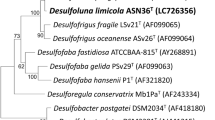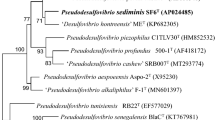Abstract
Five strains of sulfate-reducing bacteria were isolated from the highest positive dilutions of a most probable number (MPN) series supplemented with lactate and inoculated with sediments from the oligotrophic Lake Stechlin. The isolates were endospore-forming and were motile by means of laterally inserted flagella. They stained Gram-negative and contained b-type cytochromes. CO difference spectra indicated the presence of P582 as a sulfite reductase. Phylogenetic analyses of the 16S rDNA sequences revealed that the isolates were very closely affiliated with the genus Sporomusa. However, sulfate and amorphous Fe(OH)3, but not sulfite, elemental sulfur, MnO2, or nitrate were used as terminal electron acceptors. Homoacetogenic growth was found with H2/CO2 gas mixture, formate, methanol, ethanol, and methoxylated aromatic compounds. The strains grew autotrophically with H2 plus CO2 in the presence or absence of sulfate. Formate, butyrate, several alcohols, organic acids, carbohydrates, some amino acids, choline, and betaine were also utilized as substrates. The growth yield with lactate and sulfate as substrate was 7.0 g dry mass/mol lactate and thus two times higher than in sulfate-free fermenting cultures. All isolates were able to grow in a temperature range of 4–37°C. Physiologically and by the presence of a Gram-negative cell wall, the new isolates resemble known Desulfosporosinus species. However, phylogenetically they are affiliated with the Gram-negative genus Sporomusa belonging to the Selenomonas subgroup of the Firmicutes. Therefore, the new isolates reveal a new phylogenetic lineage of sulfate-reducing bacteria. A new genus and species, Desulfosporomusa polytropa gen. nov., sp. nov. is proposed.


Similar content being viewed by others
References
Altschul SF, Madden TL, Schäffer AA, Zhang J, Zhang Z, Miller W, Lipman DJ (1997) Gapped BLAST and PSI-BLAST: a new generation of protein database search programs. Nucleic Acids Res 25:3389–3402
Bak F, Pfennig N (1991) Sulfate-reducing bacteria in littoral sediment of Lake Constance. FEMS Microbiol Ecol 85:43–52
Bak F, Scheff G, Jansen KH (1991) A rapid and sensitive ion chromatographic technique for the determination of sulfate and sulfate reduction rates in freshwater lake sediments. FEMS Microbiol Ecol 85:23–30
Boga HI, Ludwig W, Brune A (2003) Sporomusa aerivorans sp. nov., an oxygen-reducing homoacetogenic bacterium from the gut of a soil-feeding termite. Int J Syst Evol Microbiol 53:1397–1404
Breznak JA, Switzer JM, Seitz H-J (1988) Sporomusa termitida sp. nov., an H2/CO2-utilizing acetogen isolated from termites. Arch Microbiol 150:282–288
Cline JD (1969) Spectrophotometric determination of hydrogen sulfide in natural waters. Limnol Oceanogr 14:454–458
Conrad R, Bak F, Seitz H-J, Thebrath B, Mayer HP, Schütz H (1989) Hydrogen turnover by psychrophilic homoacetogenic and mesophilic methanogenic bacteria in anoxic paddy soil and lake sediment. FEMS Microbiol Ecol 62:285–294
Cypionka H, Pfennig N (1986) Growth yields of Desulfotomaculum orientis with hydrogen in chemostat culture. Arch Microbiol 143:366–369
Dehning I, Stieb M, Schink B (1989) Sporomusa malonica sp. nov., a homoacetogenic bacterium growing by decarboxylation of malonate or succinate. Arch Microbiol 151:421–426
Felsenstein J (1993) PHYLIP 3.5. University of Washington, Seattle
Gerhardt P, Murray RGE, Wood WA, Krieg NR (eds) (1994) Methods for general and molecular bacteriology. ASM, Washington, D.C.
Klemps R, Cypionka H, Widdel F, Pfennig N (1985) Growth with hydrogen, and further physiological characteristics of Desulfotomaculum species. Arch Microbiol 143:203–208
Kohring LL, Ringelberg DB, Devereux R, Stahl DA, Mittelman MW, White DC (1994) Comparison of phylogenetic relationships based on phospholipid fatty acid profiles and ribosomal RNA sequence similarities among dissimilatory sulfate-reducing bacteria. FEMS Microbiol Lett 119:303–308
Laanbroek HJ, Pfennig N (1981) Oxidation of short-chain fatty acids by sulfate-reducing bacteria in freshwater and marine sediments. Arch Microbiol 128:330–335
Lovley DR, Klug MJ (1983) Sulfate reducers can outcompete methanogens at freshwater sulfate concentrations. Appl Environ Microbiol 45:187–192
Mesbah M, Premachandran U, Whitman W (1989) Precise measurement of the G+C content of desoxyribonucleic acid by high performance liquid chromatography. Int J Syst Bacteriol 39:159–167
Möller B, Oßmer R, Howard BH, Gottschalk G, Hippe H (1984) Sporomusa, a new genus of gram-negative anaerobic bacteria including Sporomusa sphaeroides spec. nov. and Sporomusa ovata spec. nov. Arch Microbiol 139:388–396
Overmann J, Tuschak C (1997) Phylogeny and molecular fingerprinting of green sulfur bacteria. Arch Microbiol 167:302–309
Peters V, Janssen PH, Conrad R (1999) Transient production of formate during chemolithotrophic growth of anaerobic microorganisms on hydrogen. Curr Microbiol 38:285–289
Pfennig N, Wagener S (1986) An improved method of preparing wet mounts for the photomicrograph of microorganisms. J Microbiol Meth 4:303–306
Rogosa M, Bishop F (1964) The genus Veillonella. III. Hydrogen sulfide production by growing cultures. J Bacteriol 88:37–41
Rothfuss F, Bender M, Conrad R (1997) Survival and activity of bacteria in a deep, aged lake sediment (Lake Constance). Microb Ecol 33:69–77
Rütters H (2001) Tracing viable bacteria in Wadden Sea sediments using phospholipid analysis. PhD thesis. University of Oldenburg, Oldenburg
Sass H, Cypionka H, Babenzien H-D (1997) Vertical distribution of sulfate-reducing bacteria at the oxic–anoxic interface in sediments of the oligotrophic Lake Stechlin. FEMS Microbiol Ecol 22:245–255
Sass H, Wieringa E, Cypionka H, Babenzien H-D, Overmann J (1998) High genetic and physiological diversity of sulfate-reducing bacteria isolated from an oligotrophic lake sediment. Arch Microbiol 170:243–251
Sass A, Rütters H, Cypionka H, Sass H (2002) Desulfobulbus mediterraneus sp. nov., a sulfate-reducing bacterium growing on mono- and disaccharides. Arch Microbiol 177:468–477
Sass H, Babenzien C, Babenzien H-D (2003) Sulfate reduction in the oligotrophic Lake Stechlin. Arch Hydrobiol Spec Issues Adv Limnol 58:37–52
Schink B (1989) Mikrobielle Lebensgemeinschaften in Gewässersedimenten. Naturwissenschaften 76:364–372
Stackebrandt E, Goebel BM (1994) Taxonomic note: a place for DNA–DNA reassociation and 16S rRNA sequence analysis in the present species definition in bacteriology. Int J Syst Bacteriol 44:846–849
Stackebrandt E, Pohla H, Kroppenstedt R, Hippe H, Woese CR (1985) 16S rRNA analysis of Sporomusa, Selenomonas, and Megasphaera: on the phylogenetic origin of Gram-positive eubacteria. Arch Microbiol 143:270–276
Stackebrandt E, Sproer C, Rainey FA, Burghardt J, Päuker O, Hippe H (1997) Phylogenetic analysis of the genus Desulfotomaculum: evidence for the misclassification of Desulfotomaculum guttoideum and description of Desulfotomaculum orientis as Desulfosporosinus orientis gen. nov., comb. nov. Int J Syst Bacteriol 47:1134–1139
Strömpl C, Tindall BJ, Jarvis GN, Lünsdorf H, Moore ERB, Hippe HA (1999) A re-evaluation of the taxonomy of the genus Anaerovibrio, with the reclassification of Anaerovibrio glycerini as Anaerosinus glycerini gen. nov., comb. nov., and Anaerovibrio burkinabensis as Anaeroarcus burkinensis [corrig.] gen. nov., comb. nov. Int J Syst Bacteriol 49:1861–1872
Stubner S (2002) Enumeration of 16S rDNA of Desulfotomaculum lineage 1 in rice field soil by real-time PCR with SybrGreen detection. J Microbiol Meth 50:155–164
Thompson JD, Higgins DG, Gibson TJ (1994) CLUSTAL W: improving the sensitivity of progressive multiple sequence alignment through sequence weighting, positions-specific gap penalties and weight matrix choice. Nucleic Acids Res 22:4673–4680
Widdel F (1980) Anaerober Abbau von Fettsäuren und Benzoesäure durch neu isolierte Arten sulfatreduzierender Bakterien. PhD thesis, University of Göttingen, Göttingen
Widdel F (1992) The genus Desulfotomaculum. In: Balows A, Trüper HG, Dworkin M, Harder W, Schleifer KH (eds) The prokaryotes, 2nd edn. Springer, Berlin Heidelberg New York, pp 1792–1799
Widdel F, Bak F (1992) Gram-negative mesophilic sulfate-reducing bacteria. In: Balows A, Trüper HG, Dworkin M, Harder W, Schleifer KH (eds) The prokaryotes, 2nd edn. Springer, Berlin Heidelberg New York, pp 3352–3372
Widdel F, Pfennig N (1981) Studies on dissimilatory sulfate-reducing bacteria that decompose fatty acids. I. Isolation of new sulfate-reducing bacteria enriched with acetate from saline environments. Description of Desulfobacter postgatei gen. nov., sp. nov. Arch Microbiol 129:395–400
Acknowledgements
The authors thank Jürgen Fröhlich (University of Mainz, Germany) for determination of the molar G+C contents of the chromosomal DNA and thank H.G. Trüper and H. Hippe for advice in taxonomic questions. This work was supported by a grant of the Deutsche Forschungsgemeinschaft.
Author information
Authors and Affiliations
Corresponding author
Additional information
Dedicated to Prof. H. G. Schlegel on the occasion of his 80th birthday.
Rights and permissions
About this article
Cite this article
Sass, H., Overmann, J., Rütters, H. et al. Desulfosporomusa polytropa gen. nov., sp. nov., a novel sulfate-reducing bacterium from sediments of an oligotrophic lake. Arch Microbiol 182, 204–211 (2004). https://doi.org/10.1007/s00203-004-0703-3
Received:
Revised:
Accepted:
Published:
Issue Date:
DOI: https://doi.org/10.1007/s00203-004-0703-3




